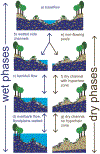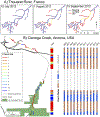River ecosystem conceptual models and non-perennial rivers: A critical review
- PMID: 33365126
- PMCID: PMC7751680
River ecosystem conceptual models and non-perennial rivers: A critical review
Abstract
Conceptual models underpin river ecosystem research. However, current models focus on continuously flowing rivers and few explicitly address characteristics such as flow cessation and drying. The applicability of existing conceptual models to nonperennial rivers that cease to flow (intermittent rivers and ephemeral streams, IRES) has not been evaluated. We reviewed 18 models, finding that they collectively describe main drivers of biogeochemical and ecological patterns and processes longitudinally (upstream-downstream), laterally (channel-riparian-floodplain), vertically (surface water-groundwater), and temporally across local and landscape scales. However, perennial rivers are longitudinally continuous while IRES are longitudinally discontinuous. Whereas perennial rivers have bidirectional lateral connections between aquatic and terrestrial ecosystems, in IRES, this connection is unidirectional for much of the time, from terrestrial-to-aquatic only. Vertical connectivity between surface and subsurface water occurs bidirectionally and is temporally consistent in perennial rivers. However, in IRES, this exchange is temporally variable, and can become unidirectional during drying or rewetting phases. Finally, drying adds another dimension of flow variation to be considered across temporal and spatial scales in IRES, much as flooding is considered as a temporally and spatially dynamic process in perennial rivers. Here, we focus on ways in which existing models could be modified to accommodate drying as a fundamental process that can alter these patterns and processes across spatial and temporal dimensions in streams. This perspective is needed to support river science and management in our era of rapid global change, including increasing duration, frequency, and occurrence of drying.
Conflict of interest statement
Conflict of Interest The authors have declared no conflicts of interest for this article.
Figures




References
-
- Acreman M, Arthington AH, Colloff MJ, Couch C, Crossman ND, Dyer F, … Young W (2014). Environmental flows for natural, hybrid, and novel riverine ecosystems in a changing world. Frontiers in Ecology and the Environment, 12(8), 466–473. https://doi-org.proxy-remote.galib.uga.edu/10.1890/130134 - DOI
-
- Allen DC, Kopp DA, Costigan KH, Datry T, Hugueny B, Turner DS, … Flood TJ (2019). Citizen scientists document long‐term streamflow declines in intermittent rivers of the desert southwest, USA. Freshwater Science, 38(2), 244–256. https://doi-org.proxy-remote.galib.uga.edu/10.1086/701483 - DOI
-
- Aspin TWH, Khamis K, Matthews TJ, Milner AM, O’Callaghan MJ, Trimmer M, … Ledger ME (2019). Extreme drought pushes stream invertebrate communities over functional thresholds. Global Change Biology, 25(1), 230–244. https://doi-org.proxy-remote.galib.uga.edu/10.1111/gcb.14495 - DOI - PMC - PubMed
-
- Benda L, Poff NL, Miller D, Dunne T, Reeves G, Pess G, & Pollock M (2004). The network dynamics hypothesis: How channel networks structure riverine habitats. Bioscience, 54(5), 413–427. https://doi-org.proxy-remote.galib.uga.edu/10.1641/0006-3568(2004)054[04... - DOI
-
- Benstead JP, & Leigh DS (2012). An expanded role for river networks. Nature Geoscience, 5, 678–679. https://doi-org.proxy-remote.galib.uga.edu/10.1038/ngeo1593 - DOI
